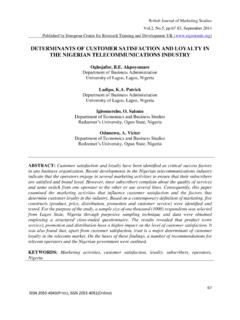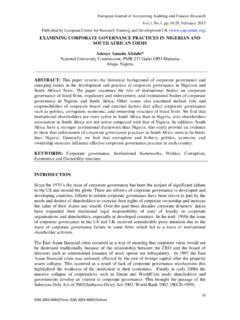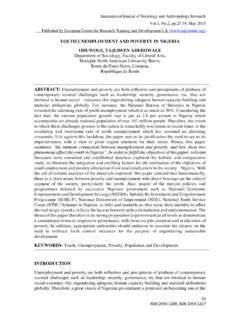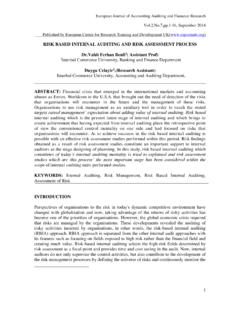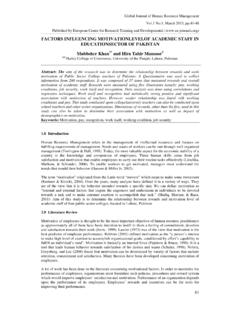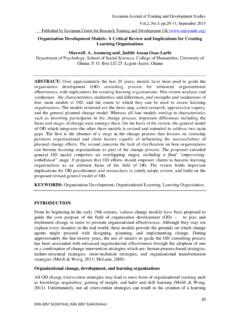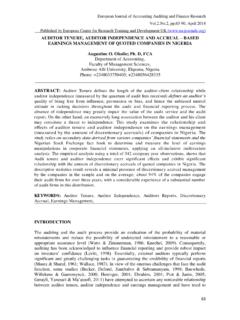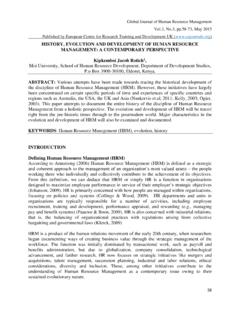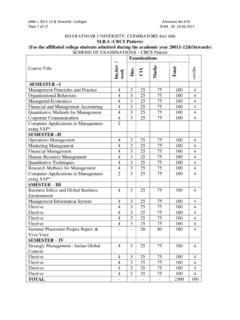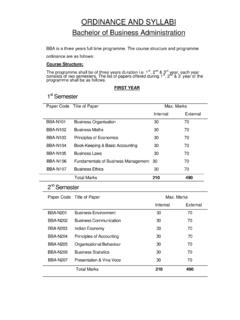Transcription of STAKEHOLDERS INVOLVEMENT IN CHANGE MANAGEMENT …
1 International Journal of Small Business and entrepreneurship Research , , , February 2015 ___Published by European Centre for Research Training and Development UK ( ) 1 ISSN 2053-5821(Print), ISSN 2053-583X(Online) STAKEHOLDERS INVOLVEMENT IN CHANGE MANAGEMENT AT KENYA POWER AND LIGHTING COMPANY LIMITED Aketch Edward Ng ong a1 and Dr. Omwono Gedion Alang o2 PhD student at the Jomo Kenyatta University of Agriculture and Technology, Kisumu Campus Lecturer at Jomo Kenyatta University of Agriculture and Technology, Eldoret Campus ABSTRACT: KPLC has over the years adopted significant changes such as introduction of the prepaid metering, the E billing and E payment system, introduction of Feeder MANAGEMENT Programmes, introduction of E -leave, rotation of jobs, upgrading systems network and company servers, installation of GPS in newly bought cars and outsourcing of non-key activities such as installations of transformers.
2 The study adopted a descriptive study design. Interview schedules were the main instrument under the study. The STAKEHOLDERS were involved in a feeder MANAGEMENT programme whose approach entails assignment of the 638 feeders across the country to specific engineers and their teams. The study found that the STAKEHOLDERS in KPLC were involved through giving their feedback to the MANAGEMENT on the CHANGE process and developing of sound procedures necessary to ensure that the changes are effective. The STAKEHOLDERS were also involved in the piloting phase before the CHANGE is rolled out and in giving their views and feedback through meetings. The study however established that there was no INVOLVEMENT of staff in the design phase of the CHANGE process. It was concluded that there was good INVOLVEMENT of STAKEHOLDERS in the execution of CHANGE process but poor INVOLVEMENT of STAKEHOLDERS in the design process of CHANGE .
3 For this reason the study recommended KPLC should involve the STAKEHOLDERS in all aspects of the CHANGE MANAGEMENT process, more so in the design of the CHANGE process and that the CHANGE process in KPLC should be documented for reference in future and to assist the organization use the information to improve future CHANGE processes. KEYWORDS: STAKEHOLDERS INVOLVEMENT , CHANGE MANAGEMENT , Kenya Power Company INTRODUCTION Background of the Study The business environment is characterized by high levels of turbulence which changes with political, economic, social, technology, environmental, and legal factors. This presents organizations with opportunities, threats, and constraints which are external influences to deal with in order to survive, grow, or die (Donald, 2004). In managing the CHANGE , it is critical to involve STAKEHOLDERS if success is to be achieved or else resistance or failure will occur when implementing CHANGE as suggested by the STAKEHOLDERS theory.
4 The stakeholder s theory states that in order for organizations to succeed and be sustainable over time, executives must keep the interests of STAKEHOLDERS aligned and going in the same direction (Freeman, 2004). CHANGE MANAGEMENT is the process of taking a planned and structured approach to help align an organization with CHANGE . In its most simple and effective form, CHANGE MANAGEMENT International Journal of Small Business and entrepreneurship Research , , , February 2015 ___Published by European Centre for Research Training and Development UK ( ) 2 ISSN 2053-5821(Print), ISSN 2053-583X(Online) involves working with an organization s stakeholder groups to help them understand what the CHANGE means for them, helping them make and sustain the transition and working to overcome any challenges involved. From a MANAGEMENT perspective, it involves the organizational and behavioral adjustments that need to be made to accommodate and sustain CHANGE (Queensland, 2009).
5 It may be impossible to effect CHANGE without any inconvenience to the existing processes and processors. In effect, CHANGE MANAGEMENT is intended to prevent disruptions and any other deliberate or inadvertent acts that would frustrate the process CHANGE , and to resolve any disruptions and their causes promptly (Oseni, 2007). CHANGE MANAGEMENT is also defined as a set of processes employed to ensure changes are implemented in an orderly, controlled and systematic manner to effect organizational CHANGE (Carnall, 2007). The Energy Sector in Kenya has undergone a number of changes in the recent past aimed at revamping and strengthening it. These changes started in 1997 when Kengen was established. According to Kengen (2011), Kengen is a limited liability company, whose core business is power generation and it is a leading electric power producer in Kenya accounting for over 80% of the total electric power consumed in the country (KenGen, 2011).
6 Overdependence on hydroelectric power generation has resulted in supply disruptions during periods of drought, with costly oil-fired sources Independent Power Producers (IPP) being used to boost output. As a result the government has sought to adopt changes and reforms that involve significant increase in geothermal and other forms of renewable supply together with other reforms in the energy sector (Kenya Institute Of Public Policy Research And Anaysis, 2007). Reforms of the energy sector commenced in the early 1990s and have been in steady progress. The electric power act in 1997 and the energy act in 2006 accelerated the reforms by promoting more private investment in generation and reviewing of tariffs. This was in order to improve financial performance of power companies (Kenya Institute for Public Research and Analysis, 2010).
7 Kenya Power and Lighting Company is a limited company that transmits, distributes and retails electricity to customers throughout Kenya. KPLC is a public company and is listed at the Nairobi Stock Exchange (NSE) and buys power from Kengen. Due to the liberalization of the energy sector, there are other small scale producers and suppliers of electricity who generate power from solar and wind (Mulila, 2010). The Board, MANAGEMENT and staff of KPLC are committed to effective implementation and continual improvement of services that complies with ISO 9001:2008 in order to consistently meet its customers and other stakeholder s requirements and expectations, KPLC has sought to undertake some changes in their MANAGEMENT and operations (KPLC, 2010). For example, it has involved staff and consultants in design and construction function by using Geographical Information Systems to plan their activities to avoid having a weak and unreliable system by aspiring for seamless processes especially when several utility companies who are also STAKEHOLDERS interact to give service to the customers.
8 KPLC involved the customers to implement the automated switching and control. This provides flexibility and reduces redundancies and links each new customer to a transformer and ensures that when changes occur on site it is affected on the database. Customers, consultants and employees have also been involved in setting up of database that includes customer information including location and contacts that enables personalized communication and services; commercial losses are reduced and revenue collection is increased to the company (KPLC, 2012). International Journal of Small Business and entrepreneurship Research , , , February 2015 ___Published by European Centre for Research Training and Development UK ( ) 3 ISSN 2053-5821(Print), ISSN 2053-583X(Online) Customer service function has introduced prepaid meters which are key among the CHANGE process in the organization to enable customers purchase a token of any denomination and feeding into these meters that would activate the kilowatt units.
9 This has involved the customers through piloting of the project and to assess the customer s satisfaction. Prepaid metering is an approach that enables customers to manage their electricity consumption cost by beforehand purchasing of electricity bundles (KPLC Annual report, 2010). Statement of the Problem Ideally, stakeholder INVOLVEMENT is critical for any given course of action in the CHANGE MANAGEMENT process. Their INVOLVEMENT is a valuable prelude in CHANGE MANAGEMENT if it is to succeed and not be resisted during implementation stage. Currently, the environment of KPLC is dynamic necessitating changes to occur within the organization to streamline it with the changes that occur in the environment. These changes are cross cutting through the key departments of Kenya Power and Lighting Company that include design and construction, customer service, transport, human resource, information technology and telecommunications and marketing department.
10 Whereas a number of studies have been done on the subject of CHANGE , a significant gap was left by not establishing STAKEHOLDERS INVOLVEMENT in the CHANGE MANAGEMENT process. For example, Mugo (2006) studied strategic CHANGE MANAGEMENT in KPLC. His study was based on general perspectives of strategic CHANGE MANAGEMENT and not on the INVOLVEMENT of STAKEHOLDERS in the CHANGE process. Mungai (2011) studied people dimensions to CHANGE using ADKAR model at KPLC and focused more on employees but did not consider other key STAKEHOLDERS who are involved in CHANGE MANAGEMENT process. Owuor (2011) studied stakeholder INVOLVEMENT in strategy formulation in Kenyan State Corporations and did not study STAKEHOLDERS INVOLVEMENT in CHANGE MANAGEMENT process in KPLC. Muhia (2011) conducted a study on MANAGEMENT of strategic CHANGE at KPLC under Project Mwangaza in 2007 and failed to establish the extent of STAKEHOLDERS INVOLVEMENT in CHANGE MANAGEMENT process at KPLC.
